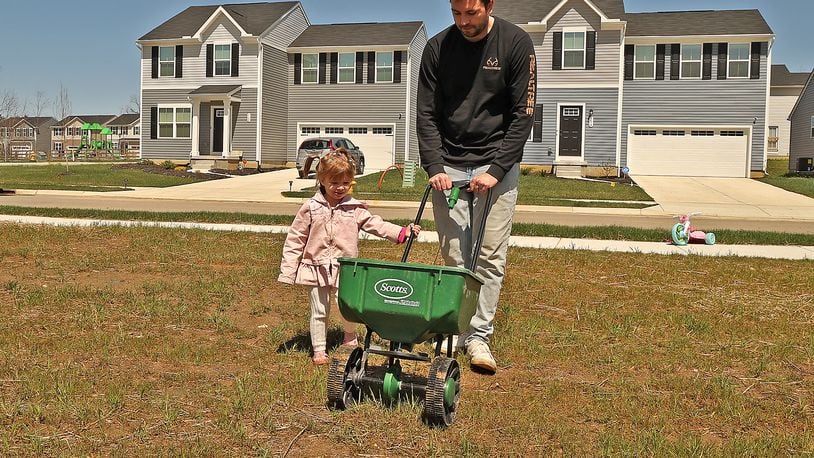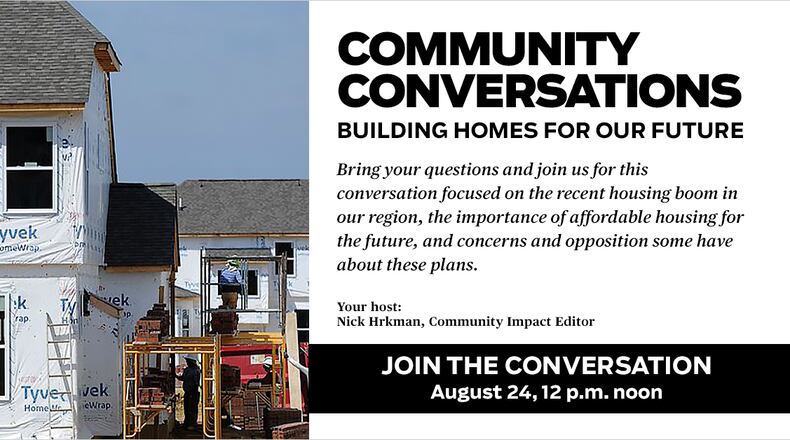The discussion was co-hosted by Community Impact Editor Nick Hrkman and reporter Cornelius Frolik. Panelists included:
- Adam Blake, Vice President of Housing for County Corp
- Tawkiyah Jordan, Senior Director for Housing and Community Strategy at Habitat for Humanity International
- Amy Riegel, Executive Director of Coalition on Homelessness and Housing in Ohio
- Matt Sauer, Dayton Plan Board member and architect
- Charlie Simms, President of Simms Development
- Vince Squillace, Executive Vice President for the Ohio Homebuilders Association
Here are some highlights from that Community Conversation. Look for continued coverage of this important topic in coming weeks.
Editor’s Note: The transcript below has been edited for brevity and clarity.
Adam Blake
While on paper it looks like Dayton is a very affordable place to live, the challenge today is that there is no housing available. Vacancy rates have never been lower in the 15 years since I’ve been doing this work and rents have never been higher. I met with a woman last week who is still couch hopping with a housing voucher. After she lost her apartment to the tornados, she cannot find a landlord to take her voucher.
Even though Dayton and Montgomery County are probably going to lose about 3,200 residents over the next five years, we’ve identified a need for 3,500 new housing units in the next three years. Greater Dayton Premier Management, which is our housing authority in Dayton, manages 3,000 housing choice vouchers. So those are those rental subsidies that people can access. And the waitlist I believe right now is at around 3,700. Again, those are people that qualify by income for that assistance, but can’t even access the voucher, let alone have those people that have vouchers. In this environment, there is very little incentive for a private landlord to accept a renter with a subsidy for their rent when what comes with that subsidy is the requirement that the unit pass an inspection. And so a lot of private landlords just don’t want to put up with the inspection process. So that forces that person to get into a situation where they have to live with another family, or just live in substandard housing.
Tawkiyah Jordan
I think there’s a part of that we can do differently to anchor investment in the community. A Community Land Trust (CLT) is basically a trust that holds properties in a collective ownership structure, where typically the housing is owned separately from the land. What it allows through that structure is for a decision-making body usually is comprised of government, private sector and residents, that gets to have some control over what happens to the structures on that property over time so it is easier to maintain affordability in those structures.
One of the reasons I came into homeownership after doing hundreds of thousands of units of affordable rental is because when you have a mortgage, you have additional stability. Even an affordable rental, which over time will either move into kind of private market in terms of the cost of those rents, or will be in need of rehab and struggled to be maintained at a high quality, because investors leave the deal. And you have to recapitalize. So we continue to buy the same units of affordable housing over and over again, during the lifetime of that housing, often while quality decreases.
So things like a CLT and a focus on longer-term or stable investments to house people, I think is actually a stronger choice, especially for government. The benefits you’re going to get out of an investment in a land trust, whether it’s local and contained to a single neighborhood or more regional and scattered-site is likely going to be a greater return on that investment than 50 rental units.
I think the more we consider these kind of shared equity models, where the homeowner gets a little something and the property itself maintains a revenue stream, I think that those models are going to become more and more popular because you’re capturing value over time that’s going to be recycled in the same property. It’s an incredibly effective model.
Amy Riegel
As we talk about statistics from around the country of units needed or the lack of affordability, New York or southern Florida tip, areas like those probably can’t catch up. Honestly, their deficits are so huge, they probably will never catch up. But in Ohio, we do have the chance to catch up. And communities like Dayton can make leaps forward. Things like tornadoes do not help us make those leaps forward. But if we can recover, we can do that. And one opportunity that we have right now is that the state did receive funds through the American Recovery Plan Act that they can use for different efforts across the state to make investments in long-term impacts. These are one-time funds, they’re never coming back again. But they still have about $1.9 billion available for investments. They’ve already spent about $3.6 billion of those funds from the federal government. However, they have not spent any on investments in affordable housing. And if we were to dedicate some of those dollars to affordable housing, that is an investment that pays dividends for years and years to come.
Matt Sauer
Our country doesn’t really have any kind of national or even quasi-regional land use policies. So what we end up with is municipalities competing against each other for development and cornfields see a lot of development, when our legacy cities already have those elements that exist today for new housing production. We’ve got streets, we’ve got schools, we’ve got roads, water, sewer, gas. All those pieces are in place.
I think density is important because we can’t afford to maintain the infrastructure we have. You see a lot of levy issues going up or income taxes being proposed in communities because somebody’s got to pay for the maintenance and upkeep of all these all these facilities. Cities have a natural advantage that, if we tack on more population, we can we can make amortize that cost over a larger group of taxpayers.
It’s sustainable, too. If you care about the environment and the future of the planet, thinking about how we live a little bit more compactly, rely less on cars, have walkable communities, all these things should be prioritized. Where we build housing is really a critical piece of this. It affects how developers look at a given project, because of appraisals and the way financing looks at surrounding properties. We should be figuring out ways to build more in places that have been underserved.
Charlie Simms
We’re talking about a housing shortage of 250,000 some units in the state of Ohio. So who’s going to build all those units? Well, it’s not the government. It’s going to have to be home builders like me. The problem that we have started with the Great Recession, where we had all these new banking regulations. The other huge thing is, when builders and developers go to get our projects approved, we run into this thing called a “NIMBY” — Not In My Backyard — and all of these neighbors come out and talk about how we’re going to ruin the community with new projects, which are actually going to create jobs, create income for their community, and then they’re their zoning boards and their city councils just fall to that pressure. And those boards and officials then don’t do the job that they they were probably elected to do because they just listened to a minority of residents.
Higher densities, such as in downtown Dayton where I built 31 units on one acre, it made the numbers work. We started our first project in Dayton at $139,900. Builders in Ohio now are fighting to get something below $300,000.
We have to start with regulations. We don’t need to increase energy standards anymore. Who’s going to pay for that? Homeowners can’t afford what we’re building now. Regulation has to come way down for us builders to be able to build and catch up with this housing shortage, because that’s what’s causing these prices to go up.
Vince Squillace
Private industry will never get a loan from anybody on a venture where there isn’t a reasonable chance for payback. So you have to look at that as the beginning point. Is it economically feasible to move ahead with the project? Ohio is very under-housed because our housing starts per capita have been one of the lowest in the nation for decades. Now, a lot of that is due to the demographics of Ohio, we’ve led the nation in that regard, too. But we’ve increased the average age and you have a bunch of old people like me, whose housing needs are different. And that housing need has to be met as well. But there’s going to have to be involvement from the government and private industry to fulfill housing needs in a meaningful way.
Housing affordability in the Miami Valley

As rents continue to climb across the region and many local residents find themselves working in occupations that on average do not pay enough for them to afford modest rental units, affordable housing is becoming an increasingly important issue for our communities and communities across the nation. New housing and commercial developments are planned across our region and each one sparks heated debate among residents who will live near them, the developers of these projects and civic leaders who must balance the needs of existing residents with growing the local economy and attracting newcomers.
» Ohio must bridge the gap between low wages and high rents
» Springfield and the entire country needs more housing, fast
» We need to be smart, responsible with our growth
» Plan provides multi-year roadmap for neighborhood solutions
» Displaced Anthony Wayne residents asking for a fair shot
» New hotel in downtown Hamilton will make the city proud
» Cost of redevelopment should not include displacing residents






